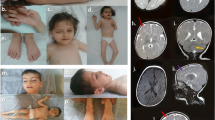Abstract
Warburg Micro syndrome and Martsolf syndrome are clinically overlapping autosomal recessive conditions characterized by congenital cataracts, microphthalmia, postnatal microcephaly, and developmental delay. The neurodevelopmental and ophthalmological phenotype is more severe in Warburg Micro syndrome in which cerebral malformations and severe motor and mental retardation are common. While biallelic loss-of-function mutations in RAB3GAP1 are present in the majority of patients with Warburg Micro syndrome; a hypomorphic homozygous splicing mutation of RAB3GAP2 has been reported in a single family with Martsolf syndrome. Here, we report a novel homozygous RAB3GAP2 small in-frame deletion, c.499_507delTTCTACACT (p.Phe167_Thr169del) that causes Warburg Micro syndrome in a girl from a consanguineous Turkish family presenting with congenital cataracts, microphthalmia, absent visually evoked potentials, microcephaly, polymicrogyria, hypoplasia of the corpus callosum, and severe developmental delay. No RAB3GAP2 mutations were detected in ten additional unrelated patients with RAB3GAP1-negative Warburg Micro syndrome, consistent with further genetic heterogeneity. In conclusion, we provide evidence that RAB3GAP2 mutations are not specific to Martsolf syndrome. Rather, our findings suggest that loss-of-function mutations of RAB3GAP1 as well as functionally severe RAB3GAP2 mutations cause Warburg Micro syndrome while hypomorphic RAB3GAP2 mutations can result in the milder Martsolf phenotype. Thus, a phenotypic severity gradient may exist in the RAB3GAP-associated disease continuum (the “Warburg–Martsolf syndrome”) which is presumably determined by the mutant gene and the nature of the mutation.


Similar content being viewed by others
References
Abdel-Salam GM, Hassan NA, Kayed HF, Aligianis IA (2007) Phenotypic variability in Micro syndrome: report of new cases. Genet Couns 18:423–435
Aligianis IA, Johnson CA, Gissen P, Chen D, Hampshire D, Hoffmann K, Maina EN, Morgan NV, Tee L, Morton J, Ainsworth JR, Horn D, Rosser E, Cole TR, Stolte-Dijkstra I, Fieggen K, Clayton-Smith J, Mégarbané A, Shield JP, Newbury-Ecob R, Dobyns WB, Graham JM Jr, Kjaer KW, Warburg M, Bond J, Trembath RC, Harris LW, Takai Y, Mundlos S, Tannahill D, Woods CG, Maher ER (2005) Mutations of the catalytic subunit of RAB3GAP cause Warburg Micro syndrome. Nat Genet 37:221–223
Aligianis IA, Morgan NV, Mione M, Johnson CA, Rosser E, Hennekam RC, Adams G, Trembath RC, Pilz DT, Stoodley N, Moore AT, Wilson S, Maher ER (2006) Mutation in Rab3 GTPase-activating protein (RAB3GAP) noncatalytic subunit in a kindred with Martsolf syndrome. Am J Hum Genet 78:702–707
Corbeel L, Freson K (2008) Rab proteins and Rab-associated proteins: major actors in the mechanism of protein-trafficking disorders. Eur J Pediatr 167:723–729
Derbent M, Agras PI, Gedik S, Oto S, Alehan F, Saatci U (2004) Congenital cataract, microphthalmia, hypoplasia of corpus callosum and hypogenitalism: report and review of Micro syndrome. Am J Med Genet A 128A:232–234
Graham JM Jr, Hennekam R, Dobyns WB, Roeder E, Busch D (2004) MICRO syndrome: an entity distinct from COFS syndrome. Am J Med Genet A 128A:235–245
Martsolf JT, Hunter AG, Haworth JC (1978) Severe mental retardation, cataracts, short stature, and primary hypogonadism in two brothers. Am J Med Genet 1:291–299
Morris-Rosendahl DJ, Segel R, Born AP, Conrad C, Loeys B, Brooks SS, Müller L, Zeschnigk C, Botti C, Rabinowitz R, Uyanik G, Crocq MA, Kraus U, Degen I, Faes F (2010) New RAB3GAP1 mutations in patients with Warburg Micro Syndrome from different ethnic backgrounds and a possible founder effect in the Danish. Eur J Hum Genet. 2010 May 26. doi:10.1038/ejhg.2010.79 [Epub ahead of print]
Sakane A, Manabe S, Ishizaki H, Tanaka-Okamoto M, Kiyokage E, Toida K, Yoshida T, Miyoshi J, Kamiya H, Takai Y, Sasaki T (2006) Rab3 GTPase-activating protein regulates synaptic transmission and plasticity through the inactivation of Rab3. Proc Natl Acad Sci USA 103:10029–10034
Warburg M, Sjo O, Fledelius HC, Pedersen SA (1993) Autosomal recessive microcephaly, microcornea, congenital cataract, mental retardation, optic atrophy, and hypogenitalism. Micro syndrome. Am J Dis Child 147:1309–1312
Yuksel A, Yesil G, Aras C, Seven M (2007) Warburg Micro syndrome in a Turkish boy. Clin Dysmorphol 16:89–93
Acknowledgments
G.B. was supported by the Deutsche Forschungsgemeinschaft (DFG; BO2985/3-1).
Conflict of interest
The authors declare that they have no conflict of interest.
Author information
Authors and Affiliations
Corresponding author
Rights and permissions
About this article
Cite this article
Borck, G., Wunram, H., Steiert, A. et al. A homozygous RAB3GAP2 mutation causes Warburg Micro syndrome. Hum Genet 129, 45–50 (2011). https://doi.org/10.1007/s00439-010-0896-2
Received:
Accepted:
Published:
Issue Date:
DOI: https://doi.org/10.1007/s00439-010-0896-2




